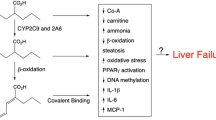Abstract
A 7-year-old boy developed a severe unilateral grand mal seizure at the age of 5 years (phenobarbitone therapy); 1.5 years later valproate (2-propylpentanoic acid, VPA) was added to the therapy. After a seizure-free period of 3 months the patient died from hepatic failure resembling Reye syndrome. Several plasma and urine samples from the final stage before and during peritoneal dialysis were analyzed by GC/MS.
The predominant feature was the abnormally increased formation of both 3 mono- and 4 double unsaturated metabolites of VPA amounting in plasma to 58%–71% of the sum of VPA plus all analyzed metabolites (controls maximal 15%) and in urine to 34%–61% (controls maximal 10%). The beta-oxidation pathway of VPA was shown to be suppressed (lack of 3-keto-VPA), whereas metabolites from the omega-oxidation pathway could still be measured (urinary 5-OH-VPA plus 2-propylglutaric acid ca. 1.6%, controls more than 10%). 4-en-VPA (2-propyl-4-pentenoic acid) (5%–21% in plasma) and 4,4′-dien-VPA (2(2-propenyl)-4-pentenoic acid) (4%–7%) have been found as abnormal unsaturated metabolites not detectable in controls. Additional typical findings were the high excretion of adipic acid, suberic acid, and 4-octen-1,8-dicarboxylic acid demonstrating the enhanced capacity of omega-oxidation in fatty acid oxidation.
Similar content being viewed by others
References
Bove KE, McAdams A, Partin JC, Hug G, Schubert WK (1975) The hepatic lesions in Reye's syndrome. Gastroenterology 69: 685–689
Brendel K, Correder CF, Bressler R (1969) The effect of 4-pentenoic acid on fatty acid oxidation. Biochim Biophys Res Commun 34:340–347
Bressler R, Corredor C, Brendel K (1969) Hypoglycin and hypoglycin-like compounds. Pharmacol Rev 21:105–130
Chalmers RA, Lawson AM (1979) Identification of 5-hydroxyhexanoic acid in the urine of twin siblings with a Reye's-like syndrome associated with dicarboxylic aciduria and hypoglycaemia and with similarities to Jamaican Vomiting Sickness. Biomed Mass Spectrom 10:444–446
Chalmers RA, Lawson AM, Whitelaw A, Purkiss P (1980) Two siblings with a Reye's-like syndrome associated with an abnormal organic aciduria, Hyperglycemia, diarrhoe, and vomiting with close similarities to Jamaican Vomiting Sickness. Pediatr Res 14:1097–2002
Glasgow AM, Chase P (1975) Production of features of Reye's syndrome in rats with 4-pentenoic acid. Pediatr Res 9:133–138
Gugler R, v. Unruh GE (1980) Clinical pharmacokinetics of valproic acid. Clin Pharmacokinetics 5:67–83
Holland PC, Sherrat HSA (1973) Biochemical effects of the hypoglycaemic compound 4-pentenoic acid and related non-hypoglycaemic fatty acids. Effect of the free acids and their carnitine esters on coenzyme A-dependent oxidations in rat liver mitochondria. Biochem J 136:157–171
Holland PC, Senior AE, Sherrat HSA (1973) Biochemical effects of the hypoglycaemic compound 4-pentenoic acid and related non-hypoglycaemic fatty acids. Effects of their CoA esters on enzymes of fatty acid oxidation. Biochem J 136:173–184
Jacobi G, Thorbeck R, Ritz A, Janssen W, Schmidts HL (1980) Fatal hepatotoxicity in child on phenobarbitone and sodium valproate. Lancet I:712–713
Kingsley E, Tweedale R, Tolman KG (1980) Hepatotoxicity of sodium valproate and other anticonvulsants in rat hepatocyte cultures. Epilepsia 21:699–704
Kingsley E, Tweedale R, Gray P, Tolman KG (1980) The role of toxic metabolites in the hepatotoxicity of valproic acid. Gastroenterology 79:1031
Klemens M (1983) Synthese und massenspektroskopisches Verhalten alpha-alkylierter aliphatischer Carbonsäuren. Dissertation, Heidelberg 1983
Kochen W, Scheffner D (1980) On unsaturated metabolites of valproic acid in serum of epileptic children. In: Johannessen SI, Morselli PL, Pippenger CE, Richens A, Schmidt D, Meinardi H (eds) Antiepileptic therapy: Advances in drug monitoring. Raven Press, New York, pp 111–120
Kochen W, Imbeck H, Jacobs C (1977) Untersuchungen über die Ausscheidung von Metaboliten der Valproinsäure im Urin der Ratte und des Menschen. Arzneimittelforsch 27:1090–1099
Kochen W, Tauscher B, Sprunck HP, Klemens M (1983) Identification and quantification of double unsaturated metabolites of valproic acid in the urine and plasma of epileptic patients on VPA therapy. J Clin Chem Clin Biochem (in press)
Loiseau P (1981) Sodium valproate, platelet dysfunction and bleeding. Epilepsia 22:141–146
Löscher W (1981) Concentration of metabolites of valproic acid in plasma of epileptic patients. Epilepsia 22:169–178
Nau H, Zierer R, Spielman H, Neubert D, Gansau Ch (1981) A new model for embryotoxicity testing: Teratogenicity and pharmacokinetics of valproic acid following constant-rate administration in the mouse using human therapeutic drug and metabolic concentrations. Life Sci 29:2803–2814
Norman MG (1968) Encephalopathy and fatty degeneration of the viscera in childhood. Can Med Assoc J 99:522–526
Parker PH, Helinek GL, Glishan FK, Greene HL (1981) Recurrent pancreatitis induced by valproic acid. A case report and review of the literature. Gastroenterology 80:826–828
Samaha RJ, Blau E, Berardini JL (1974) Reye's syndrome: Clinical diagnosis and treatment with peritoneal dialysis. Pediatrics 53: 336–346
Schäfer H, Lührs R (1978) Metabolite pattern of valproic acid. Arzneimittelforsch 28:657–662
Schneider A, Wacarda L, von Klitzing E, Kochen W, Hellenbrecht D (1983) Experimental observations on peritoneal transport in rabbits. Kidney Int 24:89–94, suppl 15
Tanaka K (1972) On the mode of action of hypoglycin A. III. Isolation and identification of cis-4-decene-1,10-dioic, cis-4-octene-1,8-dioic, glutaric, and adipic acids, N-(methylenecyclopropyl) acetylglycine, and N-isovaleryl-glycine from urine of hypoglycin A-treated rats. J Biol Chem 247:7465–7478
Tang TT, Siegesmund KA, Sedmak GV, Casper ST, Varma RR, McCreadic SR (1975) Reye syndrome: A correlated electronmicroscopic, viral, and biochemical observation. JAMA 232: 1339–1342
Zafrani ES, Berthelot P (1982) Sodium valproate in the induction of unusual hepatotoxicity. Hepatology 2:648–649
Zimmermann HJ, Ishak KG (1982) Valproate-induced hepatic injury: analysis of 23 fatal cases. Hepatology 2:591–597
Author information
Authors and Affiliations
Additional information
Dedicated to Prof. H. Bickel on the occasion of his 65th birthday
Supported by Deutsche Forschungsgemeinschaft (program “Research in Epilepsy”)
Rights and permissions
About this article
Cite this article
Kochen, W., Schneider, A. & Ritz, A. Abnormal metabolism of valproic acid in fatal hepatic failure. Eur J Pediatr 141, 30–35 (1983). https://doi.org/10.1007/BF00445664
Received:
Accepted:
Issue Date:
DOI: https://doi.org/10.1007/BF00445664




